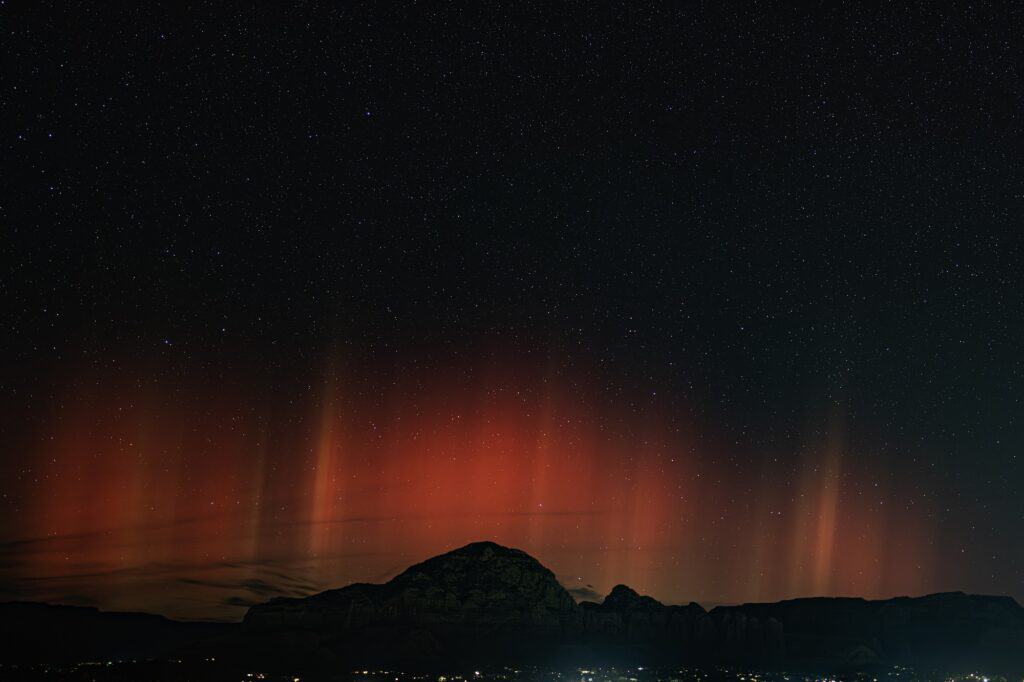In the last two weeks, we’ve seen some amazing astronomical and atmospheric phenomena.

Photo courtesy Tom Anderson
First, we saw red glimpses of the Aurora Borealis last week, caused by a coronal mass ejection of plasma from our sun slamming charged particles into earth’s protective magnetic field, causing the atmosphere to fluoresce and glow.
Farther north, the glow is green, but in lower latitudes like Arizona, we got a deep red glow that Sedona residents and visitors witnessed with the naked eye, enhanced by modern digital cameras.
This week, we saw the two-mile-wide C/2023 A3 Tsuchinshan-ATLAS comet as it passed its perihelion around the sun, extruding a massive tail of dust and ice that stretched over 18 million miles behind it. For comparison, the moon is an average of 238,855 miles from the earth, or 1/75th that distance.
David Jolkovski/Larson Newspapers
The C/2023 A3 comet appears to be on a hyperbolic orbit from the Oort cloud, meaning it may never have orbited the sun before and may never return.
If it does indeed have an elliptical orbit — the immense scale is hard to determine — it may take 80,000 years to return. If and when it last passed through our skies, most of northern Europe and the Canadian Shield was covered in ice, our most advanced technological achievement was flint tools and early modern humans were only recently migrating north out of Africa into the Near East and southern Eurasia, encountering Neanderthal and Denisovan hominids.
The scale of the space beyond our solar system is almost unfathomable for the human mind to comprehend. We call our skies the “universe,” but that’s not accurate.
On a brilliant dark night, with the moon absent, we can only see 3,000 to 4,000 stars with the naked eye, or roughly 9,000 to 10,000 stars combined in the Northern and Southern hemispheres.
Even with a good telescope, we may see 50,000 to 100,000 of the faintest stars around us, but most of those are in the Orion Arm, a spur of the Milky Way galaxy about one-third to one-half of the way to the rim from the galactic center. If you were to count these 100,000 stars, then travel to each one and count 100,000 new stars around every single star of them without counting any star twice — and then did that 40 times, you’d approximate the 400 billion stars that there are in the Milky Way.
The mathematics of the universe’s size are also hard to comprehend. If the galaxy were as large as the United States with the center of the galaxy placed in Kansas, we’d be as far away as Denver. All the stars we can see at night would only stretch as far as the Denver city limits. The sun would be half the size of a red blood cell at that scale and the orbit of Neptune would be only a centimeter in diameter, the orbit of Pluto half a centimeter beyond that — our whole solar system could fit on your thumb.
The Oort cloud from which C/2023 came would be a sphere of ice, rock and dust 150 feet in diameter.
At that scale, the nearest star to our sun, Proxima Centauri — 4.246 light years away — would be 584 feet distant. If you were holding our solar system on your thumb, on the streets of Denver, Proxima Centauri would be on the 50th floor of the Republic Plaza building. The 93.016 billion-light-year-wide observable universe would reach the orbit of Neptune.
And the earth, the only home our species has ever known, where all known life in the universe exists, would be orbiting the sun one fingerprint ridge away, on a sphere three times smaller than a single coronavirus.
We know what little we do because astronomers study the stars, calculating the minute physics of light to measure the gravitational pulls and orbits of the stars beyond. Photons of light weigh nothing and yet carry the weight of the stars to our telescopes.
Flagstaff is home to Lowell Observatory, from which Clyde Tombaugh discovered Pluto in 1930, while other Lowell astronomers discovered the rings of Uranus, the three largest known stars — KW Sagitarii, V354 Cephei and KY Cygni — and hundreds of asteroids, minor planets, comets and exoplanets around other stars. We know of at least 1.9 million asteroids larger than a kilometer in the asteroid belt, catalogued through the work of Lowell scientists.
On Saturday, Nov. 16, the observatory will be opening its new 40,000-square-foot, $53 million Lowell Discovery Center. I recently took a tour of the facility with Lowell historian and Sedona resident Kevin Schindler and will have a story on it for next week’s edition. We’re lucky to have such a major research observatory right in our backyard, which places the latest understanding of our solar system, galaxy and universe at our fingertips.
Sedona, Cottonwood, Camp Verde and the Village of Oak Creek are all International Dark Sky Communities with lighting rules designed to preserve our night skies, so we can revel in our brilliant night skies, contemplating both our inconceivably insignificant smallness and also the wonder that, if we are indeed alone in the universe, we may be the only ones to appreciate the interstellar beauty and give meaning to the vast infinite.